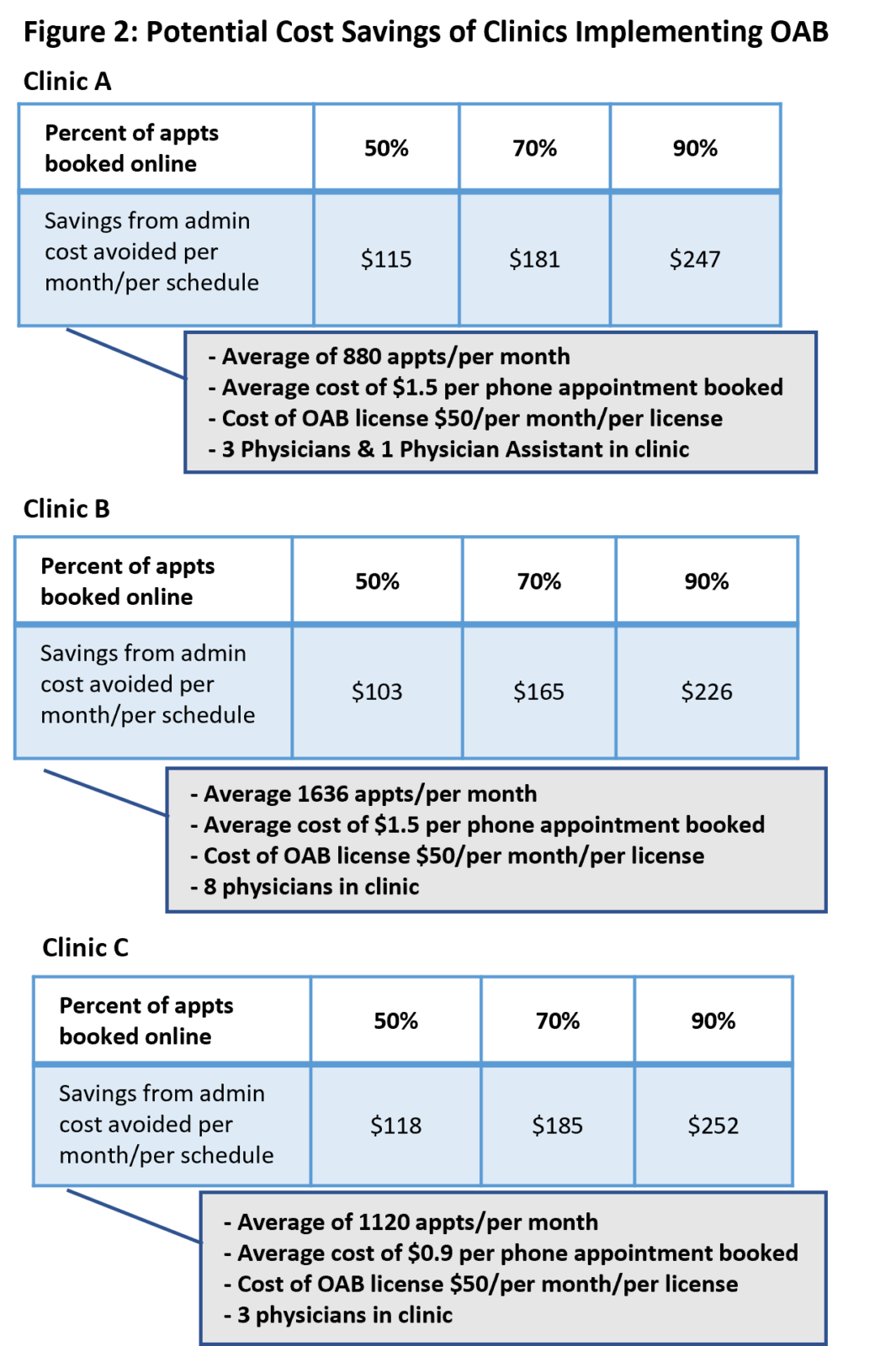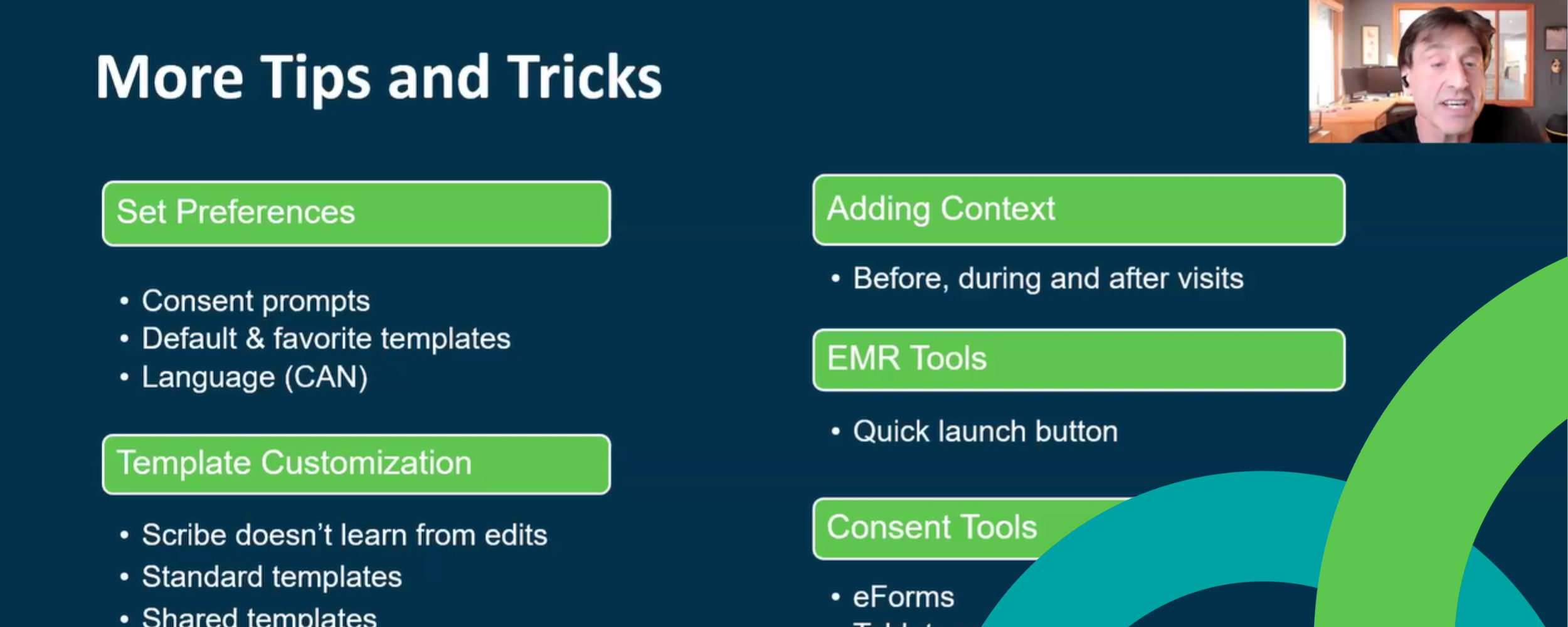Online Appointment Booking: A case study on potential cost-savings from a Family Health Team perspective
Ontario Health has provided funding for the installation, onboarding, and licensing costs for healthcare practitioners who have implemented Online Appointment Booking (OAB) as members of an Ontario Health Team. This is part of the Government’s goal to advance the adoption of digital health services and improve access to high-quality care for all Ontarians.
Compared to traditional methods of medical appointment booking, OAB proves several benefits for multiple stakeholders. By providing patients with the autonomy to search for appointment times linked directly to their healthcare practitioners’ schedules and select the most convenient time slot for their appointment, OAB promotes patient-centeredness and improves health care quality.1 In addition to improving the patient experience, clinics may also see several benefits through the adoption of OAB practices. Without OAB, clinic staff spend a significant amount of time fielding inbound calls and confirming appointments with patients.3 Implementing OAB will allow clinic staff to spend their working hours on other value-added tasks, cutting down traditional patient follow-up methods.2
Traditional methods of medical appointment booking by phone can cost between $1-5 each and amount to 25 percent of the cost of running a clinic.3 Implementing OAB can cut such costs by approximately 70 percent as there is not a need for a designated receptionist to field patient booking calls.3 In addition to less time spent fielding phone calls, OAB has shown a reduction in missed appointments, leaving the healthcare practitioners’ schedules running optimally.
Key takeaways
Online Appointment Booking platforms that are integrated into the clinic’s EMR can create administrative efficiencies, resulting in potential cost savings for clinics.
SRS Medical adopted OAB to improve workflow efficiencies, reduce the cost of clinic expenses, and empower their patients to be proactive about the care process and management of their well-being. The clinic experienced several benefits related to administrative efficiencies, outlined in Figure 1.

I have seen the effects of overworked and overwhelmed staff in our office. We are always looking for ways to improve efficiency and lessen stress. Online booking has definitely contributed positively to both of those aspects. Decreasing the amount of emails and phone calls for appointments has lessened staff demands and allows for more time to better tackle the many other tasks that need completion.
Kindra Murphy
SRS Medical Office Manager
Figure 2 presents an Economic Assessment conducted with 3 clinics to illustrate the future expected savings from administrative costs avoided per month for each health care practitioner, in three different clinics.
- Administrative costs avoided are related to the number of minutes saved by administrators from a reduction of time spent on scheduling and confirming appointments over the phone.
- Clinic A has implemented OAB for a period of 3 months; Clinic B has implemented for 2 months; Clinic C has implemented for 1 month.
- Potential future conversion rates range from 50% to 90% of OAB in clinics.
The clinics presented have experienced a gradual increase in uptake of OAB each month since implementation. Currently, OAB conversion rates at the clinic range from 5% to 10% of appointments. Most OAB licenses cost clinics an average of $50/per month/license. It is expected as more patients learn about the availability of OAB and become comfortable with the technology, more appointments will be converted to OAB over time. Taking into account the licensing cost of $50 a month per license, this represents potential cost savings for physicians ranging from $103 to $252 per month.
As more data becomes available, the Economic Assessment will include actual conversion rates clinics are experiencing and will be updated on a regular basis to reflect current conversion rates and the cost savings associated.

1Zhao, P., Illhoi, Y., Lavoie, J., Lavoie, B. J., & Simoes, E. (2017). Web-Based Medical Appointment Systems: A Systematic Review. Journal of Medical Internet Research, 134.
2Telus Health. (2019, May). Rethinking primary care delivery in the digital age. How Canadian practices are using technology to become more efficient and patient-focused. .
3Canadian Healthcare Technology. (2018, May 1). Online scheduling for clinics can reduce costs. Retrieved from https://www.canhealth.com/2018/05/01/online-scheduling-for-clinics-can-reduce-costs-restore-profitability/
Interested in learning more?
Interested in partnering with us or learning more about
what we can offer you? Please reach out here.
Get the latest resources and insights
-

Phishing: The Hidden Threat in Your Inbox
Email is a lifeline for healthcare communication, but it has become a major vulnerability. From…
-

From burnout to brilliance: A webinar on how AI scribes are helping clinicians reclaim their time
In our recent webinar, From Burnout to Brilliance: Leveraging AI Scribes and Other AI for…
-

Patient experience with eReferral in Ontario Health East Region
Patients who are emailed appointment information and reminders report an improved healthcare experience and prefer…
-

How AI scribes can help combat the family doctor shortage in Ontario
AI scribe technology is helping reduce physician burnout in Ontario by automating documentation tasks, improving…